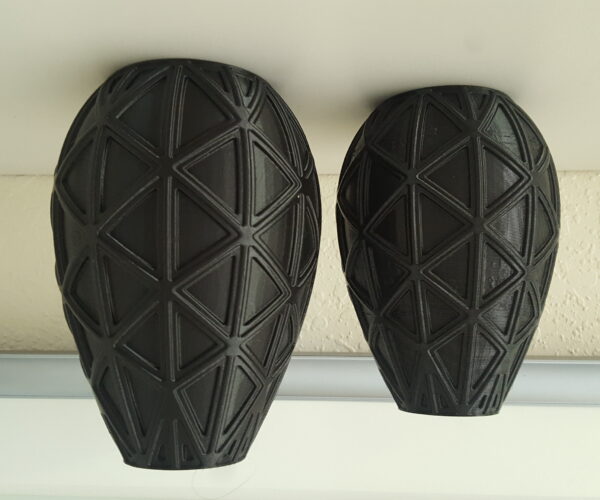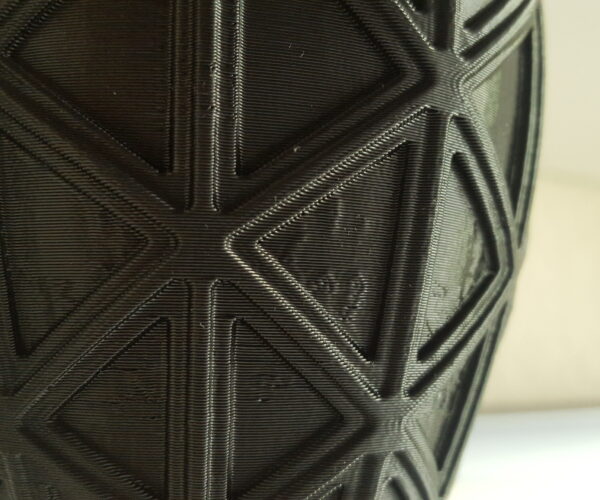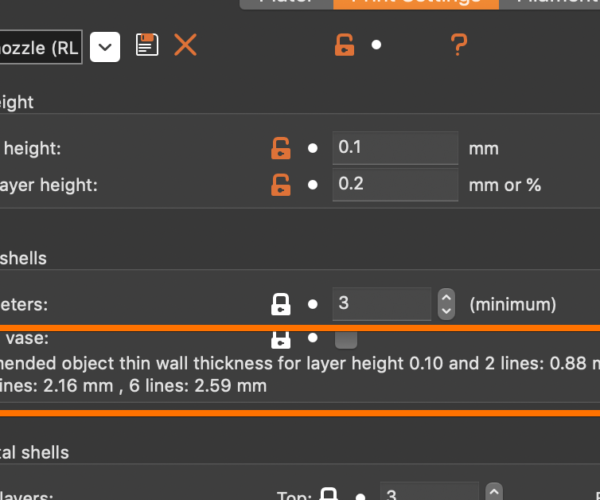RE: Surface irregularities
[...] Same filament, same printer, same settings. Smaller vase done first, not vase mode.
What could cause the surface irregularities?
Slice both and compare them in preview mode. I suspect the walls are thicker on the larger vase, allowing internal irregularities to be hidden. Are they the same model simply rescaled?
and miscellaneous other tech projects
He is intelligent, but not experienced. His pattern indicates two dimensional thinking. -- Spock in Star Trek: The Wrath of Khan
RE: Surface irregularities
Yes, walls are thicker, by one perimeter. Same model, just scaled.
See photo of two walls. Maybe it is the white 'gap fill' feature in combination with the broken yellow perimeter that is the cause.
Mk3 - 1X
Mk3S - 2X
2021 Hyundai Palisade
Wife - 1X
RE: Surface irregularities
[...] Yes, walls are thicker, by one perimeter. Same model, just scaled.
See photo of two walls. Maybe it is the white 'gap fill' feature in combination with the broken yellow perimeter that is the cause.
Is the smaller version the one on the left? Did you scale up from the smaller to create the larger, or down from the larger to create the smaller?
Whichever is on the right in your last pic looks "right". The walls print with even perimeters with your current perimeter extrusion width setting. Whenever you have uneven infill, be it broken runs of internal perimeters or gap fill, it can create an irregular outer surface. I also see the purple wiggly bits where PrusaSlicer is adding infill to compensate for thin walls.
Assuming the original is the larger on the right and the smaller at left is the size you want, I'd try:
If it's a model of your design, make the walls a bit thicker.
Add an external perimeter. This may not help much, but some internal areas may be printed as solid perimeters rather than a mix.
Try thinner extrusion widths. Look at the tooltip hint PrusaSlicer gives you for extrusion widths. If using a 0.4mm nozzle, set a default extrusion and perimeter widths to 0.4mm and re-slice and see if the internals are more regular.
and miscellaneous other tech projects
He is intelligent, but not experienced. His pattern indicates two dimensional thinking. -- Spock in Star Trek: The Wrath of Khan
RE: Surface irregularities
My model. Right is scaled up from left.
I'll just increase the wall thickness on the Solidworks model. I try to have minimum wall thickness to reduce print time.
Thanks.
Mk3 - 1X
Mk3S - 2X
2021 Hyundai Palisade
Wife - 1X
RE: Surface irregularities
If you're designing the parts yourself, take a look at Print Settings->Layers and perimeters->Vertical shells. The notes below the perimeter count will give some hints as to the ideal wall thickness. If you adjust your extrusion widths, these values will change.
and miscellaneous other tech projects
He is intelligent, but not experienced. His pattern indicates two dimensional thinking. -- Spock in Star Trek: The Wrath of Khan



